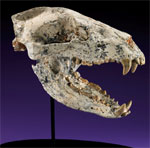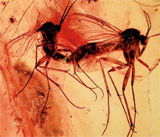Dino tracks lead to phenomenal Martian rock in Chait’s May 6 Natural History auction
April 10th, 2012 by admin
Tissint Martian meteorite that fell to earth July 18, 2011; believed to have solidified from lava 400-500 million years ago, extraordinarily rare, est. $200,000-$300,000. I.M. Chait image.
BEVERLY HILLS, Calif. – I.M. Chait’s industry-leading Natural History sales are a showcase for once-in-a-lifetime specimens, like the spectacular meteorite from Mars that headlines the company’s May 6 auction. Extraordinarily rare, the fist-size rock that landed in an African desert last July 18 probably took hundreds of millions of years to travel from Mars to earth.
It is known as the Tissint Meteorite – a reference to the name of the Moroccan town nearest to where nomads in the Oued Drâa valley found the fusion-crusted stone after it made its dramatic landing. According to eyewitnesses, a yellow fireball streaked across the sky, turned a bright green color, then split into two parts as two loud sonic booms were emitted. Experts would later determine – amid much excitement – that the specimens found near Tissint had originated on Mars.
“Less than 0.1% of all known meteorites are recorded as Martian in origin, and since this was the first Martian meteorite fall to be observed since 1962, it is most likely the only such fall that will be observed in most current earth inhabitants’ lifetimes,” said Chait’s natural history director, Jake Chait.

Baby Triceratops prorsus skull – “Samantha” – approx. 68-65 million years old, found at Hell Creek Formation, Montana; skull measuring 36 in. long, 22 in. wide, est. $60,000-$80,000. I.M. Chait image.
The entire Tissint fall is thought to comprise little more than 10kg (approx. 22 lbs.) of material. London’s Natural History Museum holds a Tissint specimen weighing 1.1kg (approx. 2.4 lbs.) and considers it the most important meteorite of the last 100 years.
One quality that makes the Tissint Meteorite so significant is its freshness. Unlike meteorites that lay undiscovered for years – in some cases, thousands of years – it has not been contaminated by the earth’s soil, water or bacteria, and therefore is a very fresh and valuable resource for the study of its home planet’s geology. Tiny air bubbles trapped in the rock may even provide insight as to the atmosphere of the Red Planet. A truly superb specimen that weighs in at 10.5 oz. (298 grams), the Tissint Meteorite is expected to make $200,000-$300,000 at auction.

Leg from Tarbosaurus bataar (relative to the Tyrannosaurus), approx. 70 to 65 million years old, 79¾ in. long, est. $20,000-$25,000. I.M. Chait image.
During the prehistoric period that the Tissint Meteor(ite) is likely to have departed Mars, the earth was inhabited by early dinosaurs and other exotic reptiles. Now animal and mineral specimens of that fascinating era will come together on the same planet in the same place, at I.M. Chait’s May 6 auction.
One of the sale’s top zoological lots is the skull of a baby (10-12 years old) triceratops found at the Hell Creek Formation in Montana, a site that produced many highly important fossils. The triceratops skull is one of very few of its type in existence. Its consignor acquired the specimen from the person who actually excavated it from the Hell Creek field. It will be offered with a $60,000-$80,000 estimate.
A jointed leg from a fearsome Tarbosaurus bataar (Tyrannosaurus) is more than 6½ feet tall and is presented on a custom metal armature. The leg dates to the end of the Cretaceous period, approximately 70 to 65 million years ago, and is in an exemplary state of preservation, from its warmly patinated surface to its wickedly curving, well-delineated claws. It could make $20,000-$25,000 on auction day.
Appropriately for the Year of the Dragon, I.M. Chait will auction a fossilized skull of a creature now known as an Ankylosaurid but originally thought to have been a dragon – and it’s easy to see why people of ancient times might have thought as such. The long snout, large spikes and cranial protrusions on the broad, flat-topped skull certainly suggest a dragon-like physiognomy. Very few Ankylosaurid remains have ever been found, more than warranting a $30,000-$40,000 presale estimate.

Fine and complete dinosaur skeleton, Psittacosaurus sp., Cretaceous, Central Asia, 39 in. long, est. $10,000-$12,000. I.M. Chait image.
A fine and complete dinosaur skeleton measuring 39 inches long would be the ultimate prize on any CEO’s desk. The specimen is a remarkably well-preserved, fully articulated skeleton of a Psittacosaurus, a primitive member of the Ceratopsia, or horned dinosaurs. In a forward-crouching mode, this beautifully presented skeleton has a large parrot-beaked skull with distinctive jaws that once grabbed and shredded leaves with ease. It has a presale expectation of $10,000-$12,000.

Sliced coprolite fossil from Sauropod, Jurassic, Tithonian stage, from Morrison Formation in Utah, est. $800-$1,000. I.M. Chait image.
In addition to their bones, dinosaurs left behind other evidence that they existed, like fossilized dung known in geological terms as “coprolites.” Two consecutive lots of coprolite fossils, cross cut and polished to reveal its inner coloration, are cataloged in the sale. A hefty 8-¼-inch wide multicolored specimen from the Morrison Formation in Utah is estimated at $800-$1,000; while a group lot of five coprolites, quite likely from ancient turtles, carries a $2,500-$3,500 estimate. Such specimens are very popular with collectors and always garner media interest. “Even a leading business publication featured a coprolite from one of our past auctions on its front page,” said Jake Chait.
Dinosaur eggs of various types and species also will be available, ranging in size from 3 to 4 inches in diameter all the way to 16 inches for an Asiatic Gigantaraptor egg. The latter is estimated at $3,000-$4,000.

Skull of Indarctos zdanskyi, predecessor to panda bear, approximately 5 million years old, est. $65,000-$80,000. I.M. Chait image.
Chait’s sale includes the only fossil of an Indarctos zdanskyi (predecessor to the panda) ever to be offered at auction. “There may be one in a museum somewhere, but if so, its existence is not commonly known,” said Chait. “We don’t even know of a private collection that contains an Indarctos zdanskyi.”
The 16-inch-long “panda” skull is around 2 million years old. Like the “dragon” in the auction, it was found in central Asia. Mounted with jaws agape, the skull displays outstanding three-dimensionality, fine bone texture and coloration. Estimate: $65,000-$80,000.
A number of insects and taxidermied animals will be auctioned. Of particular note is a pair of large mosquitoes captured in amber resin while in the act of mating. Described in Chait’s catalog as “a perfect snapshot of prehistoric life,” the 2¼-inch-long golden-orange specimen of Baltic origin could realize $500-$700.

Mating mosquite pair captured in amber, Upper Oligocene Epoch/Paleogene Period, est. $500-$700. I.M. Chait image.
The Archaeological and Tribal Artifacts section of the sale includes an authenticated Egytian mummified human hand with a considerable amount of cloth wrapping still intact. It is at least 2,000 years old, putting it somewhere between the New Kingdom and Ptolemaic Eras. Estimate: $5,000-$6,000.
Other lots of interest include an attractive glass-encased display containing both hair and a tusk section from a Mammathus primigenius (woolly mammoth elephant), $1,200-$2,500); group lots of ancient arrow and spear points from North Africa, certified gemstones, and many other mineral specimens – from earth and beyond.
I.M. Chait’s Sunday, May 6 Important Natural History auction will commence at 11 a.m. Pacific time at the company’s gallery located at 9330 Civic Center Dr., Beverly Hills, CA 90210. All forms of bidding will be available, including live via the Internet through LiveAuctioneers.com and Artfact.com.
For additional information on any lot in the sale or to obtain a fully illustrated color catalog ($35 + shipping), call 1-800-775-5020 or 310-285-0182; or e-mail joey@chait.com. Visit the company online at www.chait.com.
